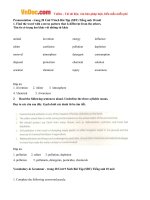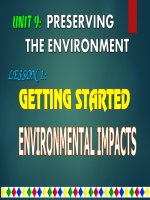Unit 09 Preserving the Environment Lesson 4 Speaking
Bạn đang xem bản rút gọn của tài liệu. Xem và tải ngay bản đầy đủ của tài liệu tại đây (99.2 KB, 3 trang )
Student teacher: Vũ Thị Mỹ Hạnh.
Instructors: Phạm Thị Lan Oanh.
Grade: 10C8
Distributive period:
Date of planning: March 18th, 2018
Date of teaching: March 22th, 2018.
UNIT 9 : PRESERVING THE ENVIRONMENT
Lesson 4: Speaking
I/ Objectives:
By the end of the lesson, students will be able to:
1. Knowledge: ( 3 basic levels: recognition, comprehension, application).
- Talk about the environment impacts of human activities.
- Practise sharing and giving responses to new information.
2. Skills:
- Use the skill(s) corresponding to each part of the lesson to do follow-up
Activities.
3. Attitude and competencies::
- Have a positive attitude towards what they have learnt.
- Understand and actively respond to relevant matters or situations.
II/ Preparations:
- Teacher: Handouts, textbook, pieces of papers and laptop.
- Students: Textbook.
III/ Anticipated problems and solutions:
- Students may not be able express their opinion about the environment impacts of
human activities by English language.
- So prepare and explain carefully before asking or suggesting them to do.
IV/ Procedures:
TEACHERS AND STUDENTS’
ACTIVITIES
1. Warm-up (5 minutes- groups work)
- T gives Ss a game “Puzzle”.
- Ss will have to match the pieces to a
correct picture
- T provides correctly pictures.
2. New lesson
CONTENTS AND BOARD DISPLAY
UNIT 9 : PRESERVING THE
ENVIRONMENT
Lesson 4: Speaking
Activity 1:
Activity 1: (5 minutes- Individual)
* Answer:
- T asks Ss to label the photos with the a. soil pollution
types of pollution.
b. water pollution
- T checks the answers and have different c. air pollution
Ss write them on the board.
d. noise pollution
Activity 2 (7 minutes- pair work)
Activity 2:
- T guides Ss to understand the
Human
Type of
requirement of this activity.
activity
pollution
- T focuses Ss’ attention on the
fossil fuel
instructions and the table.
burning by
- T asks Ss to work in pair and read the
motor
text carefully before they complete the
vehicles,
air
table. T reminds them to refer back to the factories,
pollution
reading text to get the necessary
aircrafts and
information.
rockets
- T encourages Ss to share their ideas
fertilizers
with a partner. T checks answers.
and pesticide
sprays,
harmful
soil
rubbish and pollution
chemicals
thrown in
the rivers
loud and
annoying
sounds from
factory
machinery,
noise
motor
pollution
vehicles,
aircraft, and
musical
instruments
Activity 3:
Activity 3 (5 minutes – pair work)
This activity focuses on speaking about
environmental impacts.
- T gives enough time for Ss to read the
conversation pairs work. T checks
comprehension as a class.
- Have Ss practise the conversation in
pairs.
Consequence
a series of
environmental
problems such
as acid rain,
greenhouse
effect, globe
warming and
health problem
contaminated
vegetation and
the decrease of
soil fertility
leading to the
negative
utilization of
land
human
psychological
and health
problems such
as stress, the
increase of
health rate and
hearing
damage
- T Monitors the activity and select some
pairs to role-play the conversation in
front of the class.
Activity 4 (10 minutes- group work)
- T focus Ss attention on the instructions.
- T divides the class into groups of 4
students.
- T allows Ss enough time to select the
type of pollution and prepare their
conversation.
- T encourages Ss to write the main
points or ideas expressed by each
speaker. T helps Ss with any problems
and reminds them that they can add their
own ideas while discussing.
Activity 5 (10 minutes- individually)
- Have Ss act out their conversations in
front of the class. Discuss their
performance as a class.
- Alternatively, have Ss discuss and act
out their conversations in groups.
3.Consolidation (2 minutes- individual)
- Summarize what they have learnt by
asking Ss some questions:
What have you learnt today?
What can you do now?
- Suggested answer:
I can talk about types of pollution and
negative effects on the environment and
human health.
4. Homework(1 minute)
- T asks students to do homework talk
about envoronmental impacts of human
activities.
- Prepare for the next lesson.
Activity 4:
Suggested answers:
Student A: Our earth is having the severe soil
pollution. The soil is very harmful now.
Student B: Yes, it is the result of human
activities. People use fertilizer and spray
pesticides, threw harmful rubbish and
chemicals in the river.
Student A: These cause the vegetation
contaminated and the decrease of soil
fertility. This leads the negative utilization of
land.
Activity 5:
.
Feedback:
............................................................................................................................................
............................................................................................................................................
............................................................................................................................................
............................................................................................................................................
............................................................................................................................................
............................................................................................................................................









